Technologies
10 Simple Ways to Improve Your MacBook’s Battery Life
We’ll tell you what to do to get more hours out of your trusty MacBook.
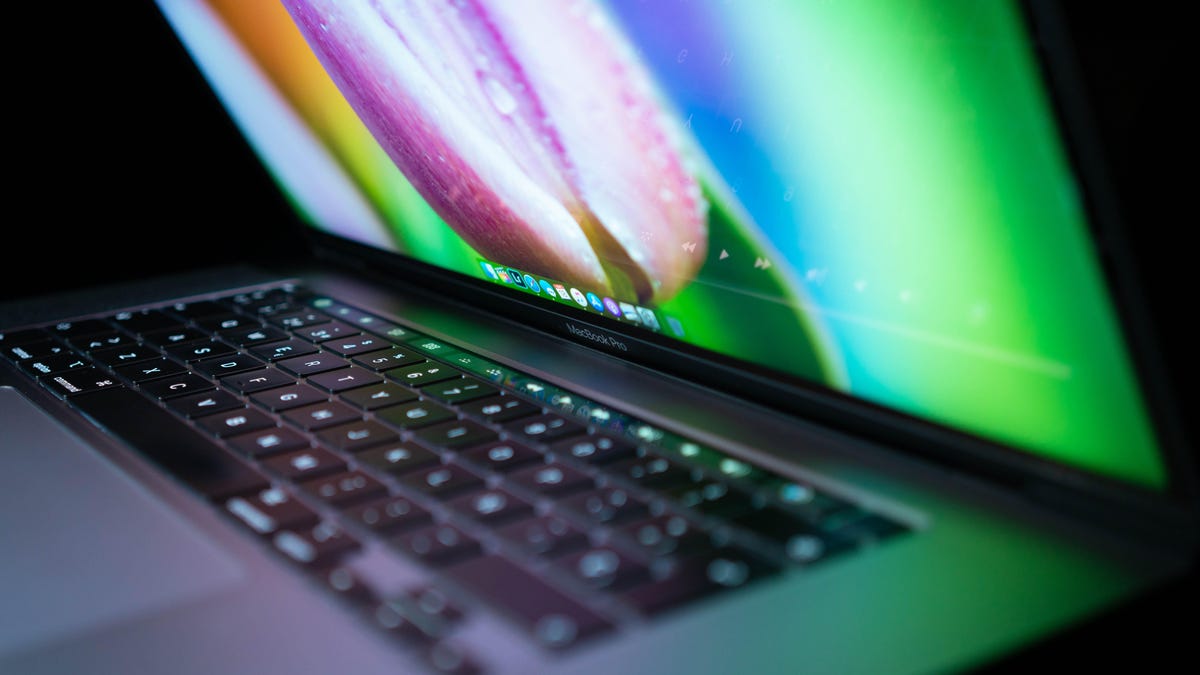
Apple’s current crop of MacBooks based on the company’s own M1 and M2 processors have better battery life than the previous Intel-based machines, but there are still some easy ways to extend your MacBook’s running time. If you’d like to improve the battery life, we’re here to say you don’t have to trail a bulky charger just to get through the day (although ancient laptop batteries may legitimately need to be replaced).
For most people, you can take a few minutes to adjust some settings to extend your laptop’s battery. Below, we’ll show you how to check its health, as well as cover tips like reducing keyboard and display brightness. We also make the case for using the Safari browser over Chrome.
Check your MacBook’s battery percentage
Keeping an eye on the remaining battery life won’t make it last any longer, but it can help you plot out how much work you can get done before you need to recharge. Click on the battery icon in the menu bar to see how the percentage of battery remaining. And if you’re running on AC power, it will give you an estimate for how long you need to continue charging the battery to bring it back 100% charged.
Here you can also see which apps, if any, are causing significant battery drain.
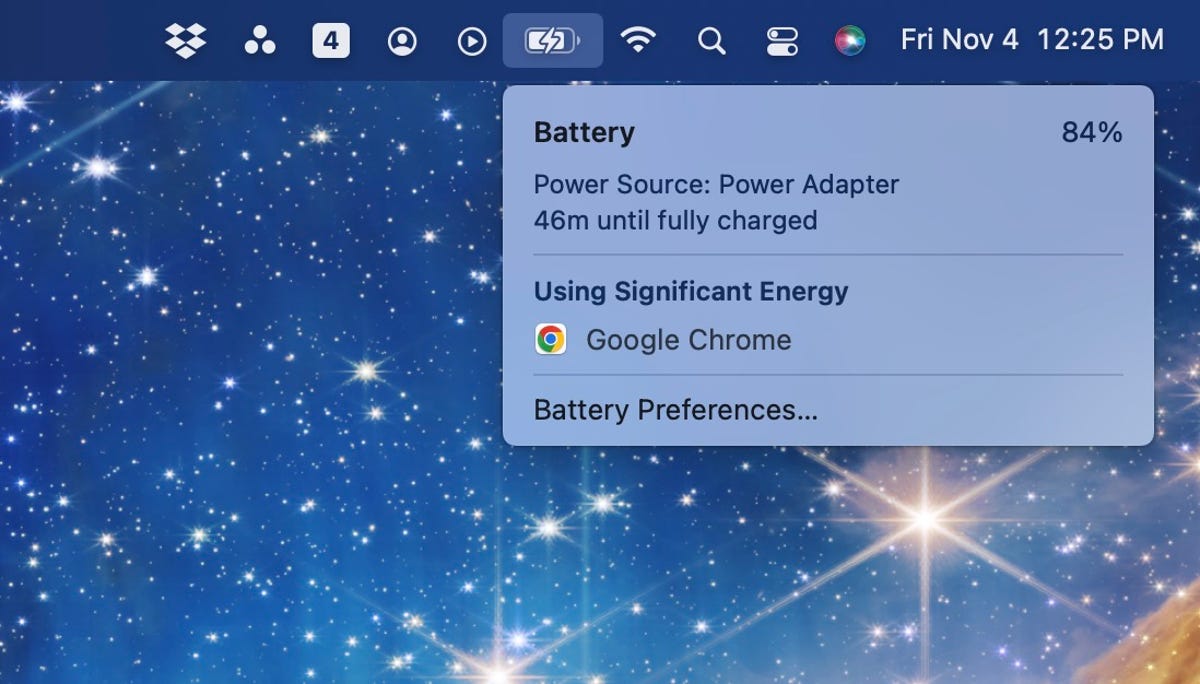
ou can see a lot of information just by clicking on the battery icon in the menu bar.
Matt Elliott/CNETCheck your MacBook’s battery health
Whether you buy a refurbished MacBook or you’ve been trying to squeeze every last ounce of life out of your aging MacBook, it’s a good idea to check your battery’s overall health. MacOS includes a tool that will tell you its potential capacity, and if you need to have it replaced.
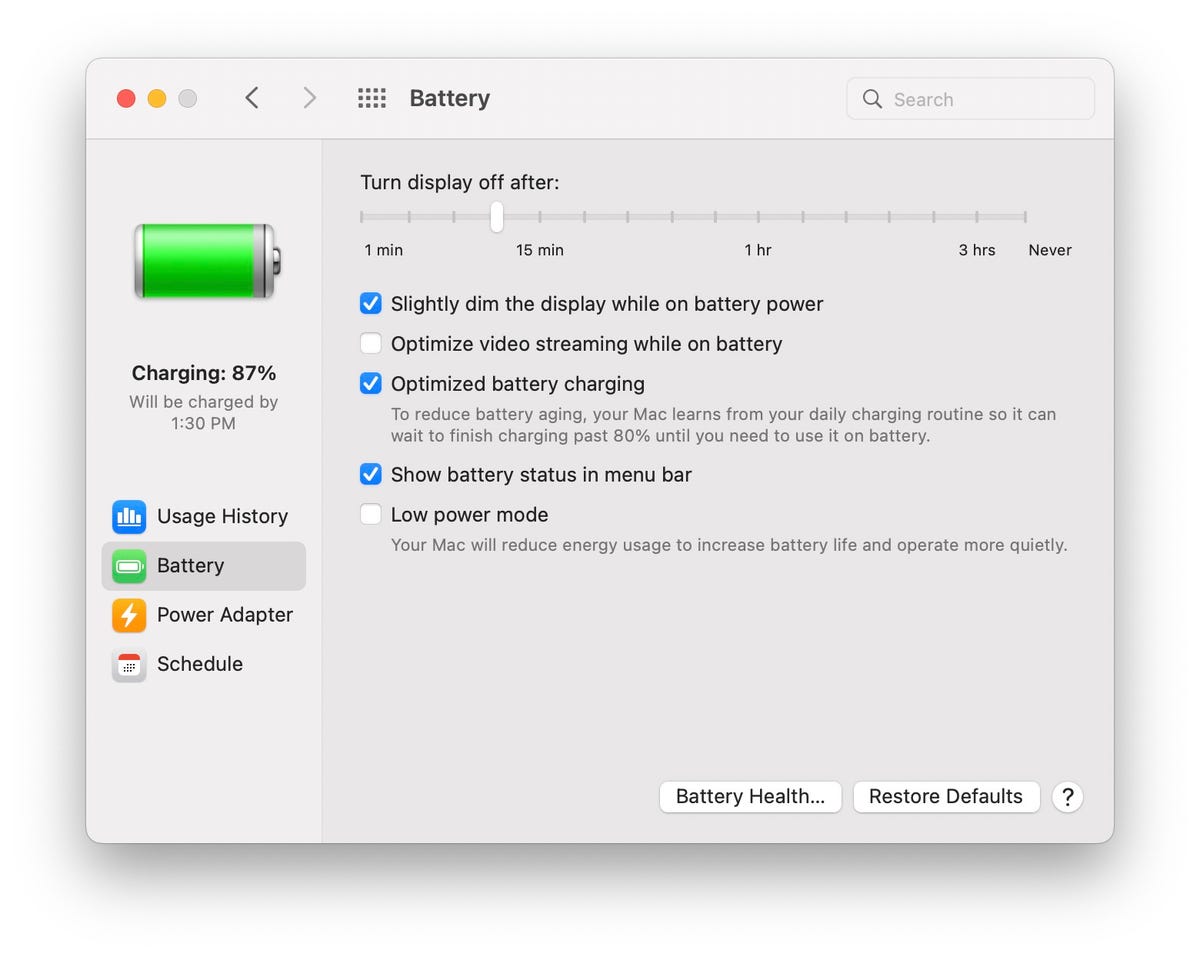
Check your MacBook’s Battery Health so you know when it’s time to get it replaced.
Screenshot by Jason Cipriani/CNETTo view your battery’s health report, click the battery icon in the menu bar, then select Battery Preferences. Next, make sure the Battery tab on the left side of the window is selected then click Battery Health. A window will pop up showing you the current condition as well as the max capacity. If you have questions or want to know more about what the status means, click the Learn More button to open an Apple support page that’s specific to your MacBook’s processor (Intel or Apple Silicon).
For those who want more insight into their MacBook’s battery history, you can view the number of charge cycles the battery has gone through. Click on the Apple icon in the upper-left corner, and then while holding in the Option key on your keyboard, click System Information. The System Information app will open, where you then need to find and select the Power section, and then look for Health Information. There you’ll see your battery’s health, capacity level and cycle count. For reference, check out Apple’s chart of the expected battery cycles. Most newer MacBook batteries have an expected life of 1,000 charge cycles, after which Apple suggests getting your battery replaced.
Optimize battery charging
If your MacBook is going to spend most of its time plugged in, you’ll definitely want to change this setting. MacOS can learn your charging habits to reduce battery aging. Click on the battery icon on the menu bar at the top of your display and select Battery Preferences from the drop-down menu as mentioned earlier. At the bottom of the list of options, select Optimized battery charging. This will slow down your charging once the battery hits 80%.
Save battery by dimming your display, optimize video streaming
Powering the display is the biggest drain on battery resources. So, first things first: Lower the brightness of your display to a level that’s comfortable for your eyes. The brighter your display, the shorter your battery life. You can also set the display to dim slightly on battery power and to shut off after a period of inactivity by going back to Battery Preferences.
There’s an option to slightly dim the screen when you’re on battery power, and to reduce battery drain when streaming video on battery power. I also suggest customizing how long your display will remain on to as short of an amount of time as you can. That way when your attention is elsewhere, your MacBook’s screen turns off completely, saving precious battery life.
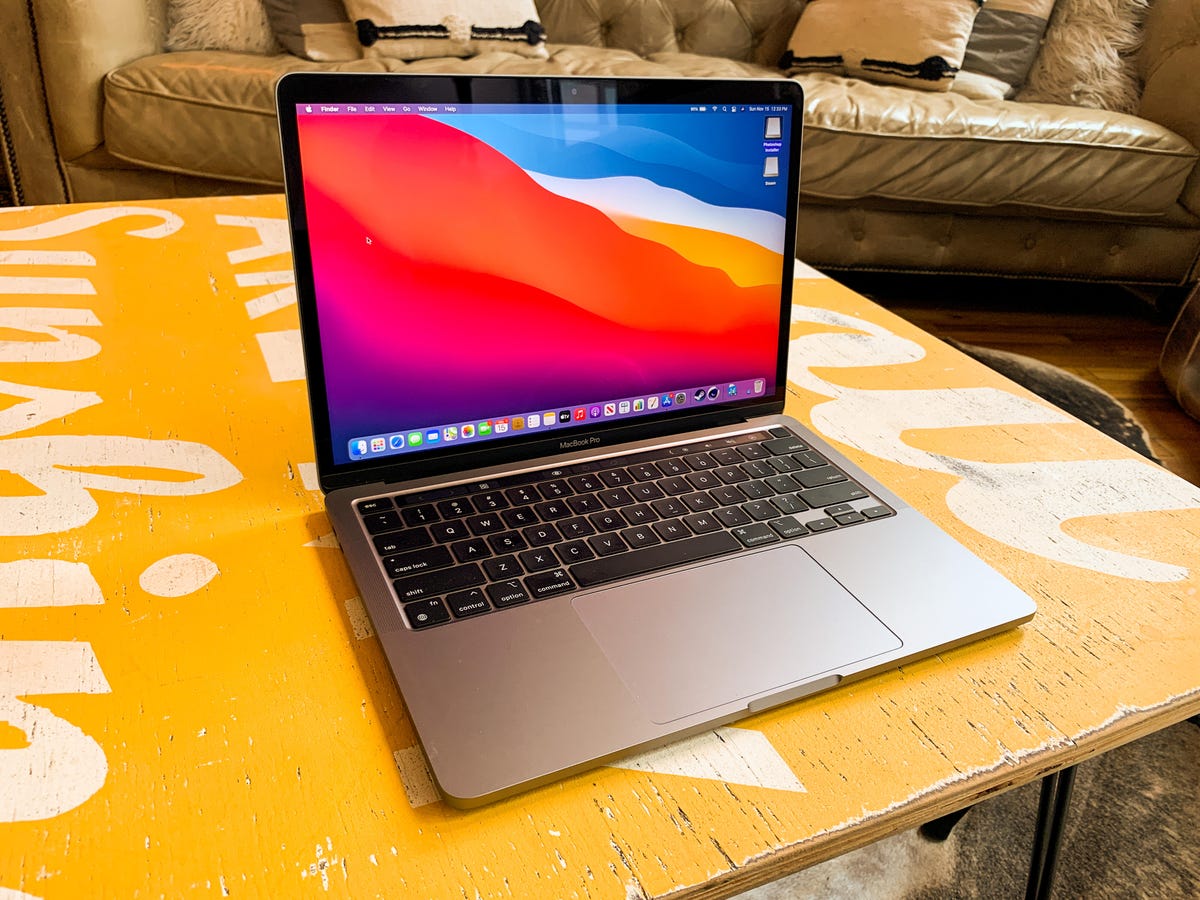
Apple’s M1 MacBooks have crazy battery life, but you can always tweak it.
Dan Ackerman/CNETKill keyboard backlights when not needed
A backlit keyboard is great for typing in the dark, but it can also drain your battery. You can set the keyboard backlights to turn off after a period of inactivity so that they’re on when you need them and off when you step away. Go to System Preferences > Keyboard. On the Keyboard tab, check the box for Turn keyboard backlight off after [X secs/min] of inactivity. Your options range from 5 seconds to 5 minutes.
I also suggest checking the box next to Adjust keyboard brightness in low light to ensure your custom brightness controls are preserved, regardless of how dim or bright the area you’re working in is.
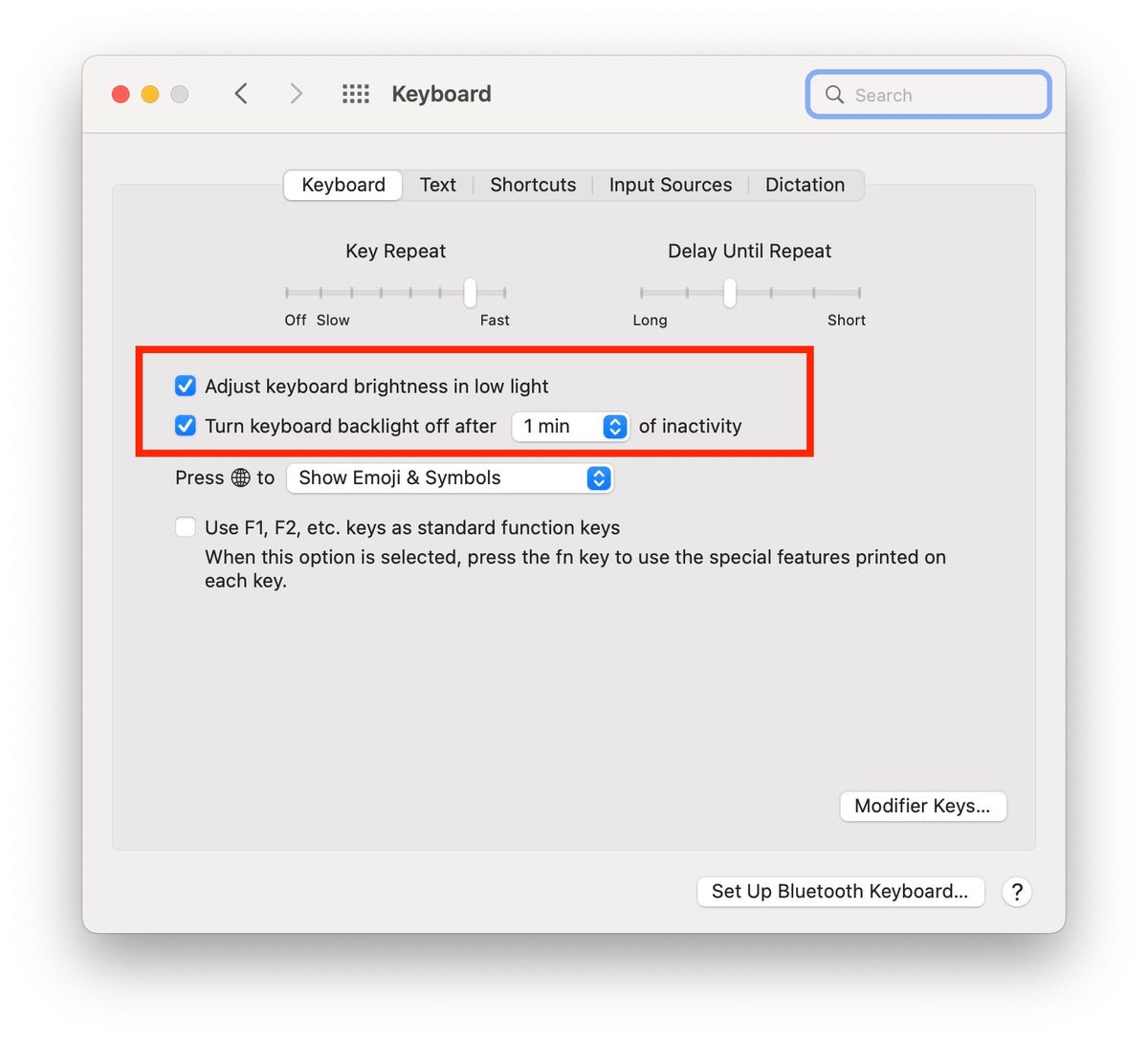
Every little bit helps, right?
Matt Elliott/CNETTurn off Bluetooth if you’re not using it
There is a good chance you won’t be carrying around a Bluetooth mouse or speaker when you leave your desk. With nothing to connect to, there is no point in having Bluetooth enabled. I recommend disabling the radio to conserve battery. Just click the Control Center icon in the menu bar, then click Bluetooth and click the switch to slide it to the Off position.
The only potential downside with disabling Bluetooth is that Apple’s Continuity feature, which allows you to quickly and easily share information between your iPhone or iPad and Mac, won’t work.
Consider switching from Chrome
If Chrome your main web browser, you might consider making the switch to Apple’s Safari browser. Chrome is a known resource hog, taking up precious memory, and by extension eating into a laptop’s battery life.
Apple’s battery life estimates for its MacBooks are calculated with Safari as the default web browser. If you’ve never used Safari as means to get around the web, you’ll be surprised at how capable it is. I personally use it as my main browser and rarely run into any issues, which wasn’t the case just a few short years ago.
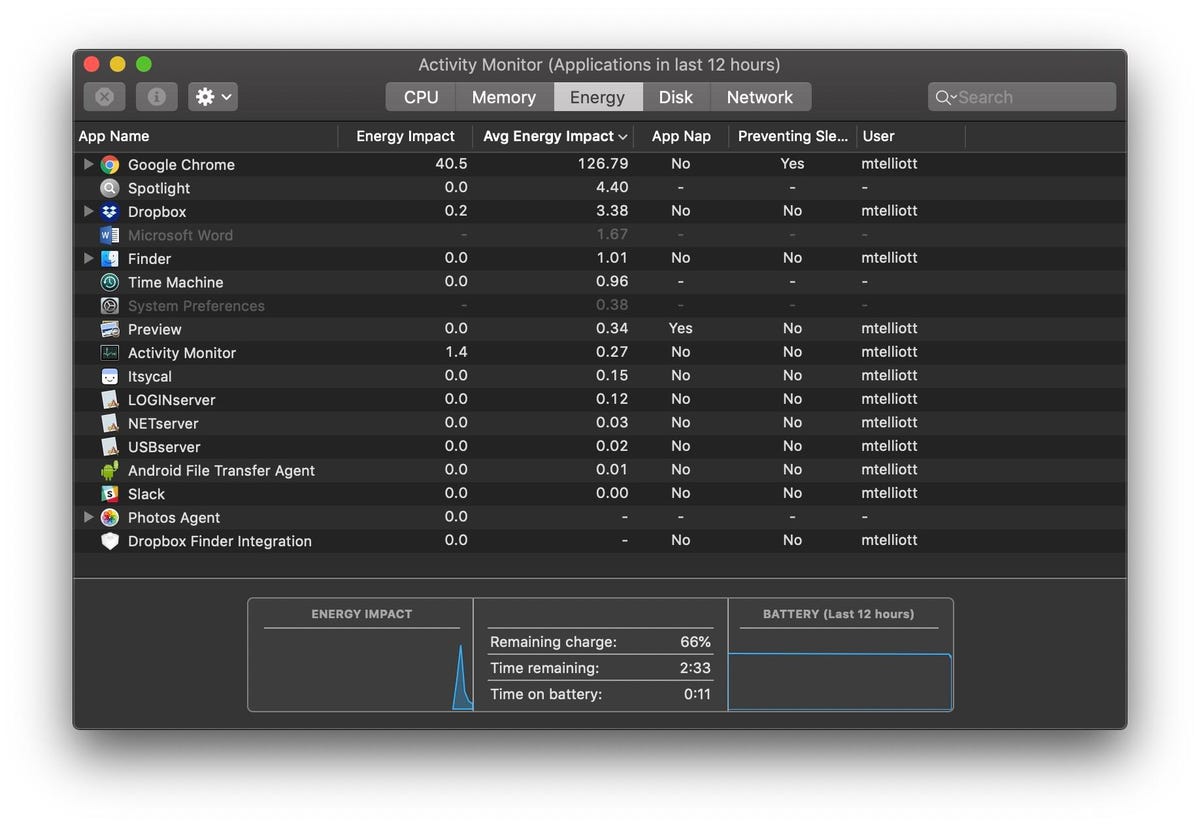
Chrome can use more than its fair share of battery resources.
Screenshot by Matt Elliott/CNETKeep current with software updates
Staying current with MacOS updates will help you get the best possible battery life. To check to see if an update is available for your MacBook, go to System Preferences > Software Update. While you’re there, check the box to Automatically keep my Mac up to date, and clicking the Advanced button will let you check for updates automatically, download them automatically or install them automatically.
Quit applications you’re no longer using
It’s best to close programs when you are done using them. This can be done by pressing the Command and Q keys at the same time, or click the program name in the menu bar and selecting the Quit option. To see how much energy each of your open applications is using, open the Activity Monitor and click the Energy tab or click the Battery icon in the menu bar.
Disconnect accessories after you’re done with them
As with Bluetooth, if you aren’t actively using a USB-connected device (such as a flash drive), you should unplug it to prevent battery drain. If the power cord isn’t connected, charging your smartphone or tablet via the MacBook’s USB port will also drain your battery.
If you’re looking for ways to get better performance out of your Mac, we have your back. We also have a long list of MacOS features that are easy to forget, but you need to know about. Before you forget, make sure to start backing up your Mac.
Technologies
Apple Desperately Needs to Launch a Foldable iPhone Flip Next Year
Commentary: Apple is the only major phone company without a folding phone. That needs to change in 2026.
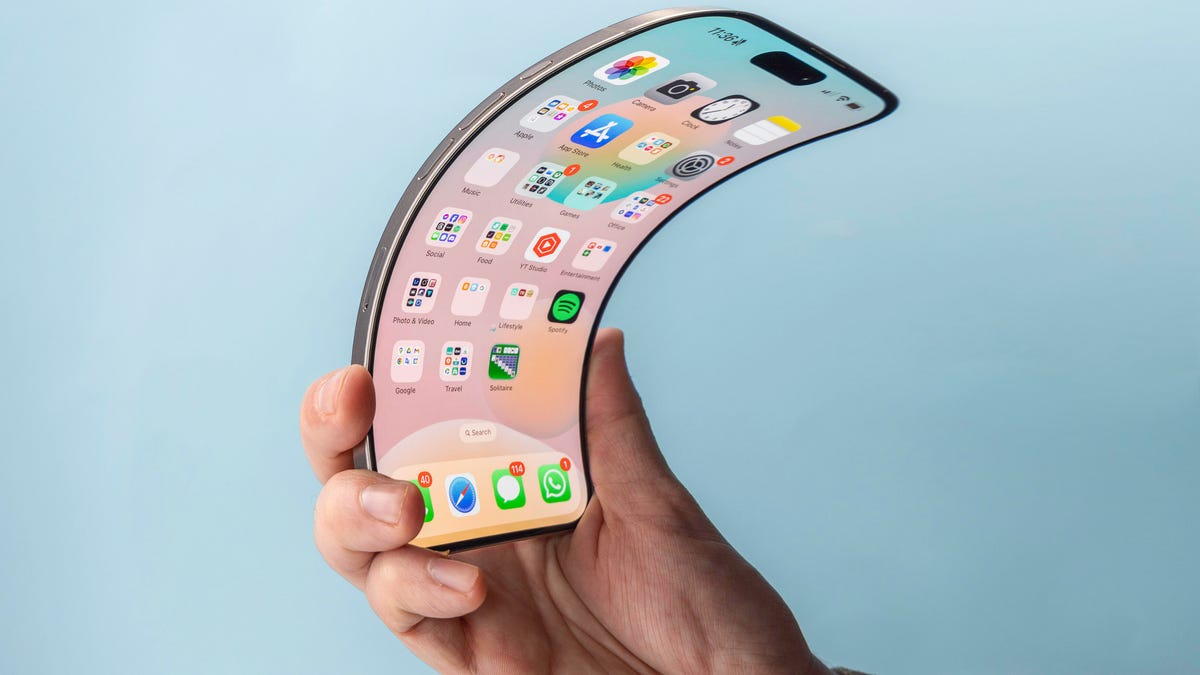
Apple’s iPhone 17 came and went and while we certainly love the iPhone 17 Pro and its vibrant cosmic orange color, I can’t help but be disappointed that the long-rumored foldable iPhone Flip wasn’t part of the company’s September launch event. Most Android phone-makers, including Samsung, Google, Motorola, OnePlus, Xiaomi and Honor are multiple generations into their own folding phone lineups, and it’s beginning to feel like Apple is late to the party. That might be a problem.
Apple dominates in the premium phone category, but foldables — which fit into the premium space in terms of price — are already nipping at its heels, with Motorola telling CNET that 20% of customers buying its Razr foldable jumped ship from Apple. Meanwhile, Samsung is in the seventh generation of its Flip and Fold series. As Lisa Eadicicco discovered during a visit to Seoul, «foldables are everywhere» in Samsung’s home country of South Korea.
With nearly every major Android phone-maker entering the foldable market, Apple risks losing potential customers. It also runs the risk of letting a rival like Samsung become the go-to name for foldables, which could make it harder for Apple to make an impact if it eventually launches its own device. Furthermore, early adopters drawn to foldable tech may be too entrenched in the Android ecosystem by the time Apple’s phone arrives to want to switch to iOS.
Apple is unlikely to be worried. It’s estimated that around 20 million foldables from all manufacturers were sold worldwide in 2023, while Apple reportedly sold 26.5 million iPhone 14 Pro Max handsets in the first half of that year alone. In 2024, foldable sales were flat — and 2025 isn’t fairing much better, according to analysts at CounterPoint Research, although Samsung did report record numbers of preorders for its latest foldable. Clearly, Apple feels it has yet to miss the boat.
Apple has always found success in biding its time, observing the industry and launching its own take on a product when it’s ready. Apple didn’t invent phones, tablets, smartwatches or computers, but it found ways to take existing products and make them more useful, more valuable in day-to-day life and — dare I say — more exciting. It’s why the iPhone, iPad, Apple Watch and Mac lines dominate the market today.
For me, I need to see Apple’s take on the foldable phone. I’ve written before about how disappointed I am in foldables. I’ve been a mobile reporter for over 14 years and phones have become increasingly dull as they’ve converged to become slight variations on the same rectangular slab.
Read more: Best Flip Phone for 2025
Foldables promised something new, something innovative, something that briefly sparked some excitement in me, but several years in, that excitement has dwindled to the point of being extinguished. They are fine products and while I like the novelty of a screen that bends, they’re not a revolution in how we interact with our phones. Not in the way that the arrival of the touchscreen was when we were still pushing buttons to type out texts.
I did hope that Google’s Pixel Fold would be the phone to catapult the foldable forward, and while the recent Pixel 10 Pro Fold — the second generation of Google’s foldable — does offer some great updates, it still doesn’t offer any kind of revolution. Instead, it feels more like a «me too» move from Google. Ditto for the OnePlus Open. So I’m left instead to look toward Apple, a company with a track record for product revolutions, to create a new take on the genre that genuinely drives forward how we use our phones.
That innovation won’t just come from the product design. Apple works closely with its third-party software developers, and it’s that input that would help a folding iPhone become genuinely useful. My biggest complaint around foldables right now is that while the hardware is decent, the devices are essentially just running standard versions of Android with a handful of UI tweaks thrown in. They’re regular phones that just happen to bend.
Few Android developers are embracing the folding format, and it’s not difficult to see why; the users aren’t there in sufficient numbers yet to justify the time and expense to adapt their software across a variety of screen sizes. The multiple folding formats already available mean Android foldables face the same fragmentation issue that has plagued the platform since the beginning. Android-based foldables are simply a more difficult platform for developers to build for than regular phones. Apple would be able to change that, as it proved with the iPhone and iPad.
Given Apple’s close relationships with top-tier developers — not to mention its own vast developer team — I expect an eventual Apple foldable to offer innovations that make it more than just an iPhone that folds in half.
And I truly hope it does. I want to look forward to tech launches again. I want to feel excited to get a new gadget in my hands and feel that «wow» moment as I do something transformative for the first time.
In short, I don’t want to be bored by technology anymore. Apple, it’s over to you.
Technologies
Today’s NYT Connections: Sports Edition Hints and Answers for Nov. 27, #430
Here are hints and the answers for the NYT Connections: Sports Edition puzzle for Nov. 27, No. 430.
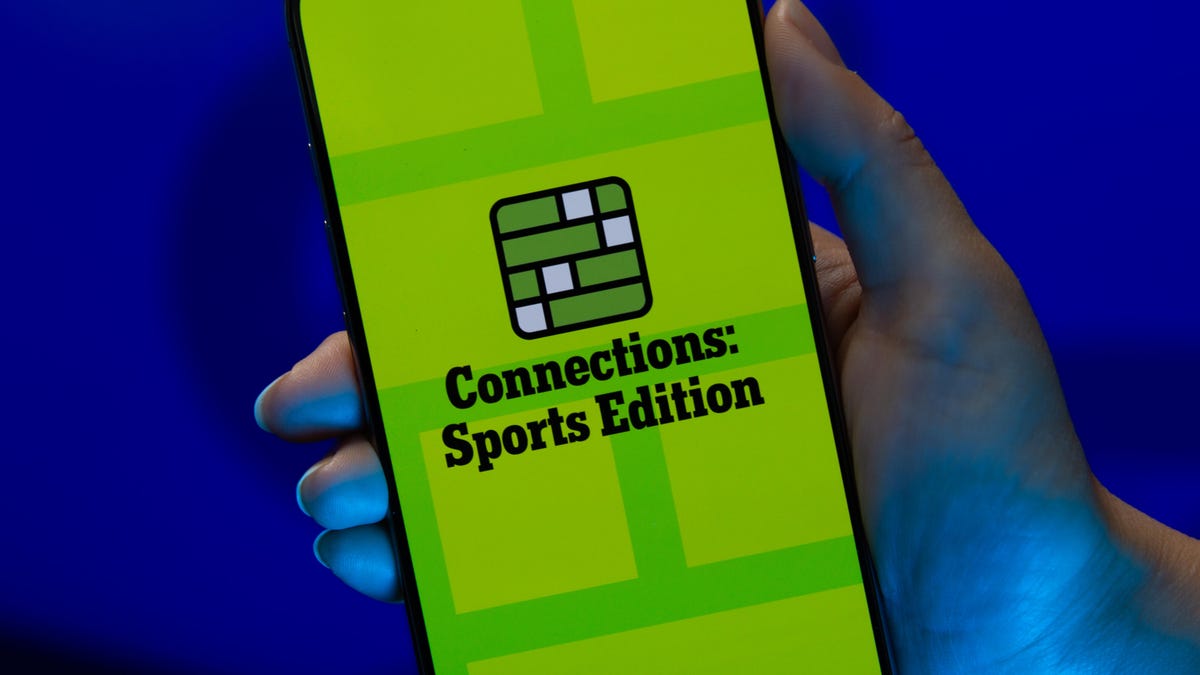
Looking for the most recent regular Connections answers? Click here for today’s Connections hints, as well as our daily answers and hints for The New York Times Mini Crossword, Wordle and Strands puzzles.
Fittingly, today’s Thanksgiving Day Connections: Sports Edition is mostly about football (although the yellow category covers all sports, really). If you’re struggling with today’s puzzle but still want to solve it, read on for hints and the answers.
Connections: Sports Edition is published by The Athletic, the subscription-based sports journalism site owned by The Times. It doesn’t appear in the NYT Games app, but it does in The Athletic’s own app. Or you can play it for free online.
Read more: NYT Connections: Sports Edition Puzzle Comes Out of Beta
Hints for today’s Connections: Sports Edition groups
Here are four hints for the groupings in today’s Connections: Sports Edition puzzle, ranked from the easiest yellow group to the tough (and sometimes bizarre) purple group.
Yellow group hint: Grab some points.
Green group hint: Pass the turkey.
Blue group hint: Face your big rival.
Purple group hint: Playing with letters in team names.
Answers for today’s Connections: Sports Edition groups
Yellow group: Places where one scores.
Green group: Associated with the NFL on Thanksgiving.
Blue group: College football rivalry «cups.»
Purple group: NFL teams, with the first letter changed.
Read more: Wordle Cheat Sheet: Here Are the Most Popular Letters Used in English Words
What are today’s Connections: Sports Edition answers?
The yellow words in today’s Connections
The theme is places where one scores. The four answers are end zone, goal, hoop and plate.
The green words in today’s Connections
The theme is associated with the NFL on Thanksgiving. The four answers are Cowboys, Lions, Madden and Turducken.
The blue words in today’s Connections
The theme is college football rivalry «cups.» The four answers are Apple, Commonwealth, Governor’s and Territorial.
The purple words in today’s Connections
The theme is NFL teams, with the first letter changed. The four answers are fills (Bills), Mets (Jets), pears (Bears) and yams (Rams).
Technologies
Today’s NYT Mini Crossword Answers for Thursday, Nov. 27
Here are the answers for The New York Times Mini Crossword for Nov. 27.

Looking for the most recent Mini Crossword answer? Click here for today’s Mini Crossword hints, as well as our daily answers and hints for The New York Times Wordle, Strands, Connections and Connections: Sports Edition puzzles.
It’s Thanksgiving, but I wasn’t too thankful for today’s Mini Crossword. It took me nearly four minutes to solve and has some very tricky clues. Read on for the answers. And if you could use some hints and guidance for daily solving, check out our Mini Crossword tips.
If you’re looking for today’s Wordle, Connections, Connections: Sports Edition and Strands answers, you can visit CNET’s NYT puzzle hints page.
Read more: Tips and Tricks for Solving The New York Times Mini Crossword
Let’s get to those Mini Crossword clues and answers.
Mini across clues and answers
1A clue: Enjoyed a Thanksgiving meal
Answer: FEASTED
8A clue: Back half of a GOAT?
Answer: ALLTIME
9A clue: Sudden urge
Answer: IMPULSE
10A clue: Santa’s landing place
Answer: ROOF
11A clue: Abstain from eating
Answer: FAST
15A clue: Tough guy
Answer: BRUISER
18A clue: Ready to use without further assembly
Answer: TURNKEY
19A clue: Some pieces of [circled letters] at the Thanksgiving table
Answer: WINGS
Mini down clues and answers
1D clue: Inside the foul line, in baseball
Answer: FAIR
2D clue: Furry monster with a falsetto
Answer: ELMO
3D clue: Pet food brand
Answer: ALPO
4D clue: Thanksgiving side dish that can fill the [circled letters]
Answer: STUFFING
5D clue: Shop ___ you drop
Answer: TIL
6D clue: M M M M
Answer: EMS
7D clue: Billy ___ Williams, actor who played Lando Calrissian in «Star Wars»
Answer: DEE
12D clue: Requests
Answer: ASKS
13D clue: «Get what I’m saying?»
Answer: SEE
14D clue: Give it a go
Answer: TRY
15D clue: «I should mention …,» for short
Answer: BTW
16D clue: N.B.A. power forward ___ Hachimura
Answer: RUI
17D clue: Large coffee dispenser
Answer: URN
-

 Technologies3 года ago
Technologies3 года agoTech Companies Need to Be Held Accountable for Security, Experts Say
-

 Technologies3 года ago
Technologies3 года agoBest Handheld Game Console in 2023
-

 Technologies3 года ago
Technologies3 года agoTighten Up Your VR Game With the Best Head Straps for Quest 2
-

 Technologies4 года ago
Technologies4 года agoBlack Friday 2021: The best deals on TVs, headphones, kitchenware, and more
-

 Technologies4 года ago
Technologies4 года agoVerum, Wickr and Threema: next generation secured messengers
-

 Technologies4 года ago
Technologies4 года agoGoogle to require vaccinations as Silicon Valley rethinks return-to-office policies
-

 Technologies4 года ago
Technologies4 года agoOlivia Harlan Dekker for Verum Messenger
-

 Technologies4 года ago
Technologies4 года agoiPhone 13 event: How to watch Apple’s big announcement tomorrow
